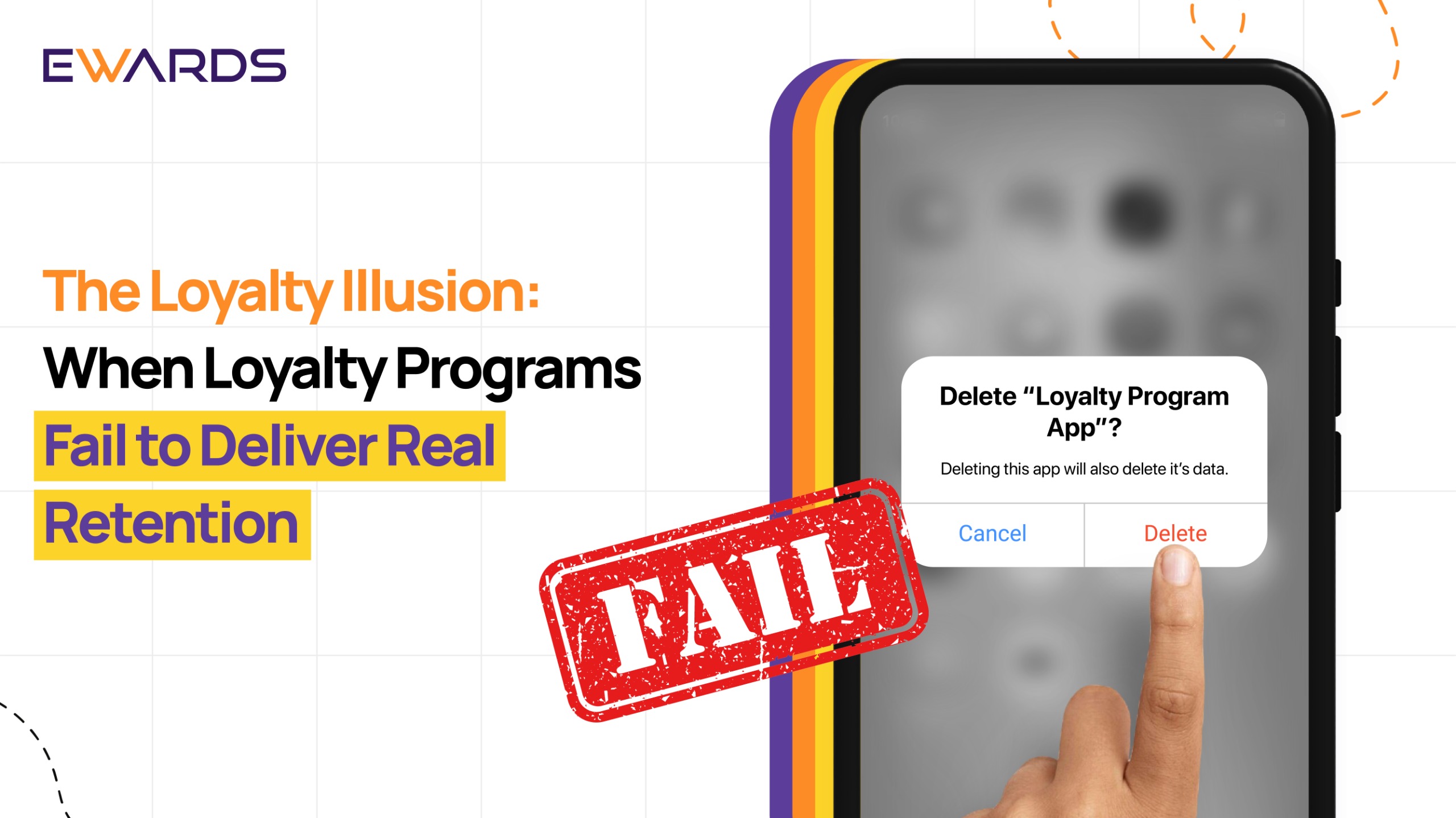
Did you know that only 49.8% of consumers redeem Loyalty Rewards worldwide?
At first glance, the programs look successful, boasting a large membership number and significant points distributed. But the real question is, are these loyalty programs effective in achieving their ultimate goal? Or are they merely creating an illusion of loyalty while the real retention is just slipping through the cracks?
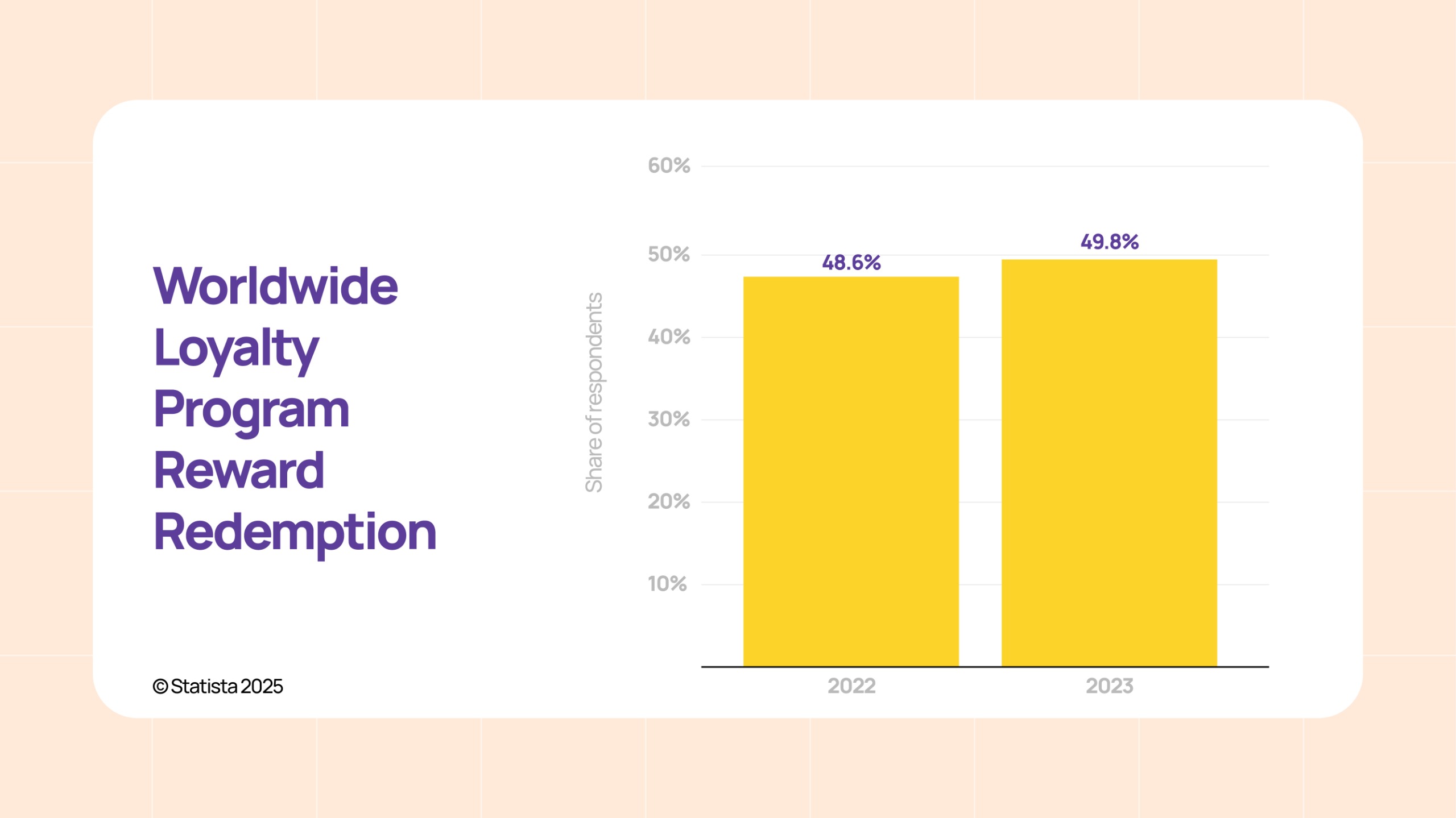
Figure: Worldwide Loyalty Program Reward Redemption
Source: (Statista, 2025)
Loyalty programs have long been hailed as the cornerstone of customer retention strategies, yet many fall short of their promises. Instead of fostering deep connections and long-term commitment, they often become transactional, uninspired, or irrelevant.
In this blog, we will peel back the “Loyalty Illusion” layers to uncover why so many programs fail to deliver real retention. Loyalty isn’t just about points or perks—it’s about building a bond that your customers wouldn’t dream of breaking.
The Loyalty Mirage: Where Numbers Do Not Tell the Whole Story
Loyalty Illusion refers to the apparent success of the Loyalty program on paper, which has failed to translate into genuine and advocated customers. This is mostly because customer loyalty is transactional, shallow, and can easily be disrupted.
The Problem of Vanity Metrics
Loyalty professionals often rely on metrics like membership size, the number of points that have been distributed, or the rate of redemption to gauge the program’s performance. Even though these metrics provide a surface-level insight into the performance of a program, they do not capture the real essence of it. For instance,
- High Membership ≠ High Engagement
A loyalty program can have a huge amount of membership but it does not necessarily mean that it can bring in a high level of engagement. This is because the same loyalty program can include numerous inactive accounts or have customers who just joined the program for a one-time incentive.
- Redemption Rate ≠ Retention
Programs that concentrate on transactional loyalty often fail to create emotional bonds with the brands, leaving the customers indifferent once the rewards run out. This means that a customer who redeems points for rewards does not necessarily mean that they are loyal, it can simply mean that they are opportunistic.
Delta Airlines SkyMiles Story
Let us consider the infamous case study of Delta Airlines’ SkyMiles loyalty program devaluation. In this, the company tried to streamline its customer rewards program structure where they significantly raised the number of points that were required to avail of the benefits of free flight. Even though these changes made perfect sense for the financial aspect of the brand, they faced a massive backlash from its most loyal customers.
- The Aftermath
- Social media erupted with criticism, labeling the program as “unfair” and “deceptive.”
- Loyal members felt betrayed, leading to a surge in negative reviews and even customer churn to competing airlines.
Lesson: Programs overly focused on cost management or metrics optimization risk alienating their most loyal customers, proving that superficial success can quickly crumble without a strong emotional foundation.
Common Pitfalls in Loyalty Programs
Strategically designed loyalty rewards are powerful drivers of customer retention and revenue growth. However, many programs falter due to recurring issues that prevent them from fostering genuine customer loyalty. Some of the common mistakes observed in the Loyalty Program are:
- Extreme Reliance on Transactional Rewards
Rewards like points, discounts, and cashback depend upon transactions. Even though this form of reward triggers instant gratification, it often fails to build longer and lasting connections with customers. Hence, building opportunistic customer behavior.
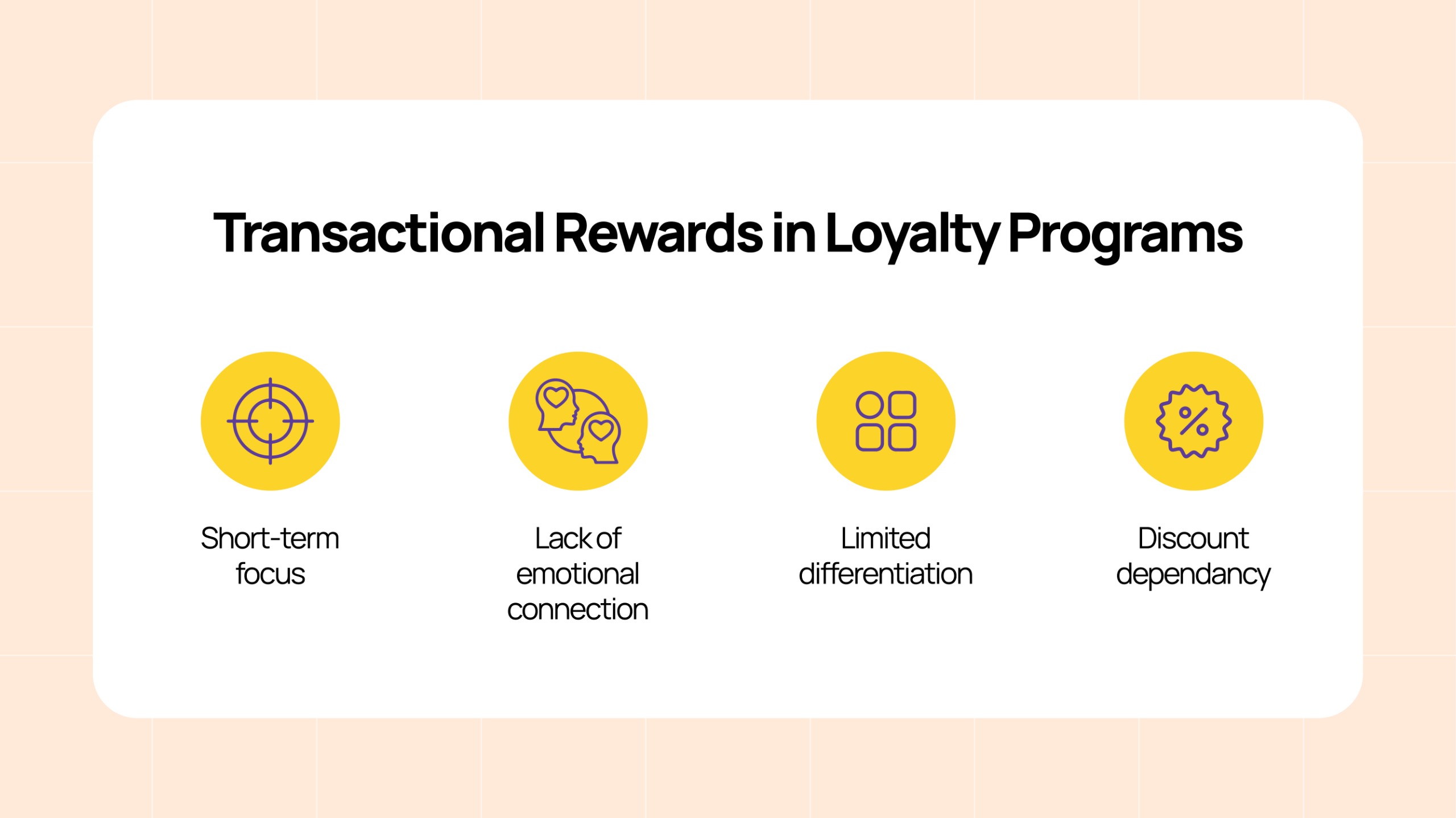
Transactional rewards secure short-term engagement but don’t translate into emotional commitment. According to an Emarsys report, 60% of loyalty programs rely heavily on discounts, perks, and rewards that they offer but only a fraction of customers report feeling emotionally connected to the brand.
- Data Mismanagement
Missed opportunities and irrelevant rewards are often the result of poor data segmentation and utilization. Businesses that fail to analyze the preferences and purchasing behavior of their customers often provide generalized offers that disengage their customers.
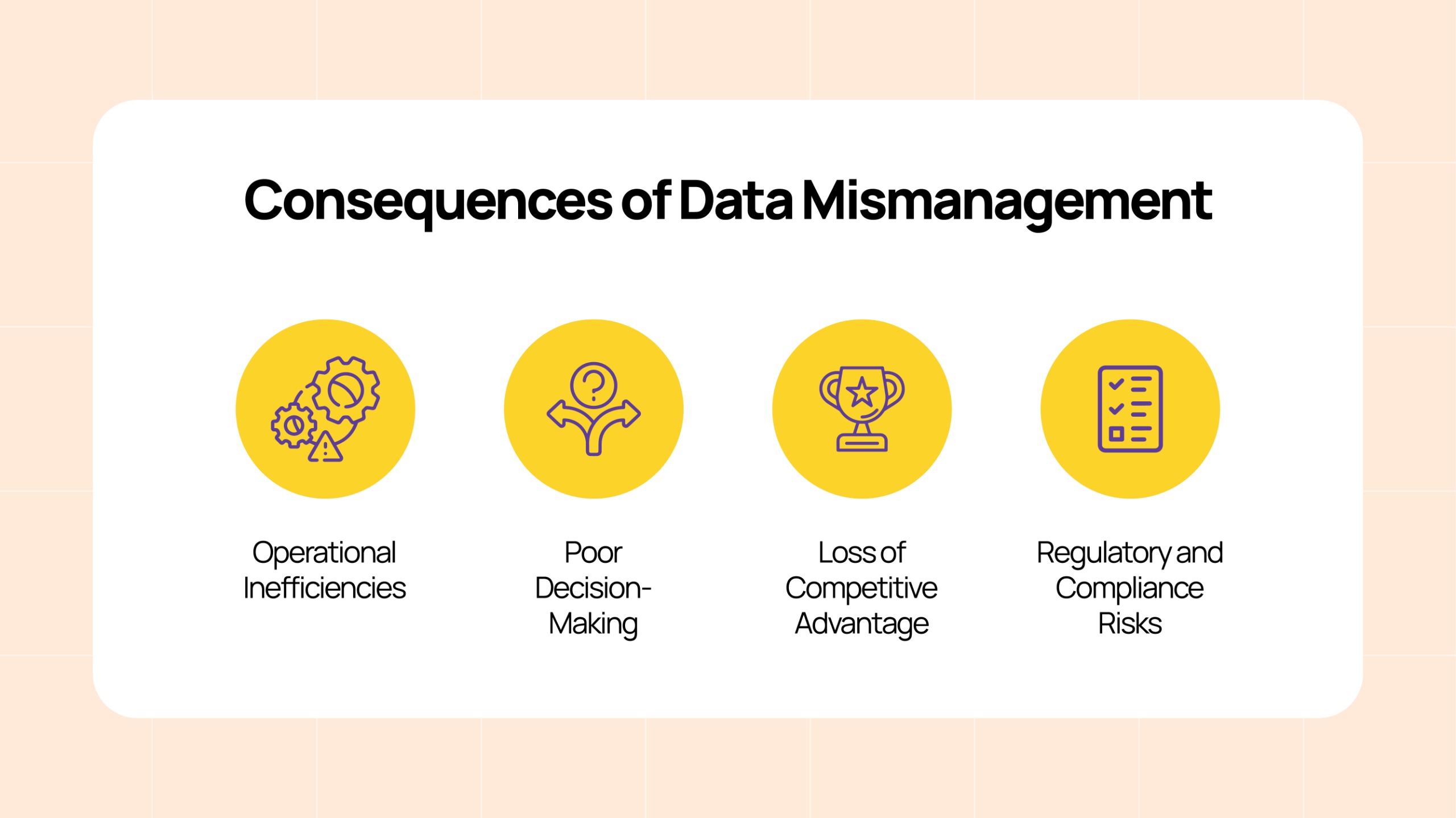
To solve this issue, the brands must use RFM (Recency, Frequency, and Moneary) analysis for segmentation along with AI-driven insights for providing their customers with tailored rewards and communications. According to McKinsey, 71% of customers expect personalized experiences, but only 22% of loyalty programs deliver them effectively.
- Ignoring Emotional Loyalty
Most of the transactional programs tend to overlook the importance of long-term relationships and building emotional relationships with customers. The basic idea of emotional loyalty comes from shared values, trust, and a sense of belongingness. When your customers feel like they belong, it is likely difficult for them to switch to your competitors.
According to a Brand Intelligence Business Motista, emotionally connected customers have a 306% higher lifetime value when compared to customers who are just satisfied with the brand. Thus, the possibility of these customers referring your brand to others is higher.
- Lack of Differentiation
Any loyalty program that is an exact copy of its competitor’s loyalty program fails to stand out in these evolving times. Without any USP, these programs will be rendered inefficient for the customers and they will not stay loyal to your brand.
The retail and F&B industries are extremely saturated which is why differentiation is an important factor. For instance, any loyalty program that offers unique experiential rewards outperforms the standard reward system.
- Reward Fatigue
Over time, repetitive or uninspiring rewards disengage customers. Without innovation, loyalty programs lose their appeal, leading to stagnant participation.
Rotating and experiential rewards reinvigorate interest and keep customers engaged. According to a Forbes study, customers are likely to be 8x satisfied when they believe that the loyalty program that the brand runs is personalized to them.
- Over-Complication of the Redemption Process
From the survey of Reward the World, it was observed that 57% of people who are active participants in the loyalty program tend to abandon it if it is hard to redeem rewards. Many loyalty programs create frustrating barriers to redeeming rewards, such as expiration dates, restrictive rules, complex tier structures, or difficult point conversions. Customers who struggle to redeem points or rewards often lose interest and disengage from the program.
How To Fix the Loyalty Illusion
While loyalty programs often struggle with vanity metrics, transactional engagement, and uninspired rewards, brands that pivot toward genuine retention strategies can transform their programs from illusion to impact.
Below are key solutions to overcome common pitfalls and craft loyalty programs that drive lasting customer connections:
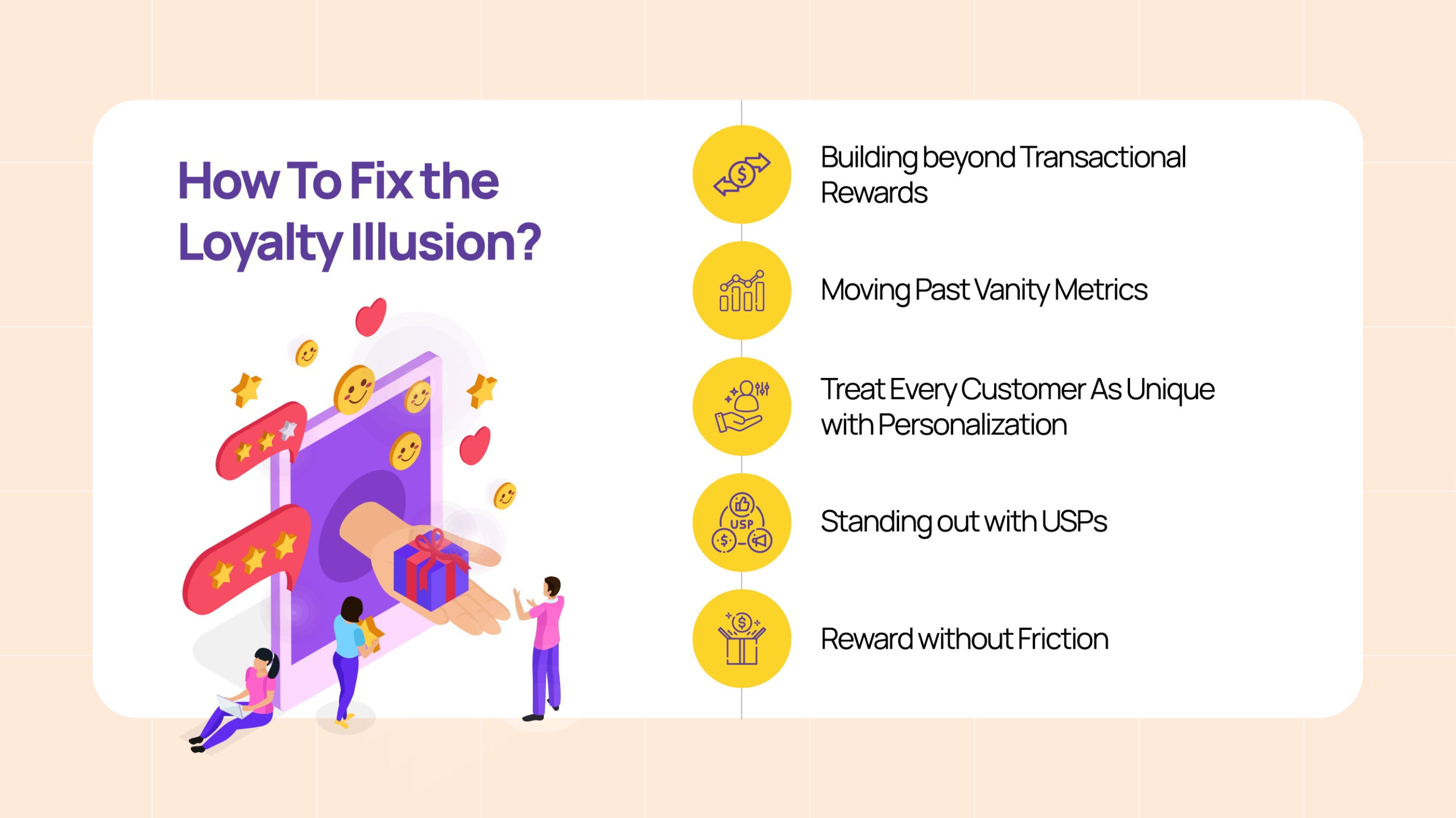
- Building Beyond Transactional Rewards
Loyalty should not just be about spending money to earn perks—it should create a sense of belonging.
- Introduce tier-based programs that reward long-term engagement rather than just purchases.
- Offer exclusive, experience-driven rewards like early access to products, VIP events, or personalized gifts.
- Engage customers beyond transactions with storytelling, community-building, and surprise-and-delight moments.
- Moving Past Vanity Metrics
Instead of tracking just the number of members or redemptions, focus on deeper engagement metrics.
- Monitor repeat purchase frequency instead of just sign-ups.
- Measure emotional loyalty through Net Promoter Scores (NPS) and customer feedback.
- Track personalized reward utilization rates—how many customers redeem rewards tailored to their preferences.
- Treat Every Customer As Unique with Personalization
One-size-fits-all loyalty programs fail. Instead, AI and behavioral analytics should guide personalized engagement.
- Use RFM segmentation (Recency, Frequency, Monetary value) to reward the most valuable customers differently.
- Offer dynamic rewards based on past behavior—like personalized discounts or exclusive recommendations.
- Introduce gamification elements (badges, status levels, milestones) to make engagement more interactive and fun.
- Standing out with USPs
In crowded markets, loyalty programs must offer something distinctive and exclusive to retain interest.
- Align rewards with brand purpose (e.g., sustainability, ethical sourcing, premium experiences).
- Provide experiential perks rather than just discounts (e.g., early access, concierge services, community events).
- Introduce collaborations or partner benefits (e.g., a fashion brand offering concert or travel perks).
- Reward without Friction
Overcomplicated redemption processes frustrate customers and lead to drop-offs.
- Make rewards easy to understand and transparent (no hidden restrictions, confusing point conversions, or short expiration dates).
- Enable instant gratification rewards (e.g., digital gift cards, seamless point-to-cash conversions).
- Offer automated reminders for unredeemed rewards so customers stay engaged.
Real-Life Loyalty Failures
Walgreens Balance Rewards – The Overhaul to MyWalgreens
The Problem: Walgreens’ Balance Rewards program was one of the largest retail pharmacy loyalty programs in the U.S. However, customers found it uninspiring and too similar to other drugstore rewards programs. Many didn’t feel motivated to engage, leading to declining retention rates.
The Fix: In 2020, Walgreens relaunched its loyalty program as MyWalgreens, shifting focus from just discounts to wellness-based rewards. Now, members earn points not just from purchases but also from healthy lifestyle activities – 4 weeks of physical activity like walking and tracking health goals. This differentiated their program from competitors like CVS and Rite Aid, turning it into a more engaging and personalized experience.
Starbucks Rewards – A Backlash Over Point Devaluation
The Problem: In 2016, Starbucks revamped its loyalty program from a visit-based model (1 star per purchase) to a spending-based model (2 stars per $1 spent). Customers who previously got rewards after 12 visits now had to spend significantly more to earn the same benefits.
In 2023, Starbucks again increased the number of points needed for free drinks, sparking massive customer frustration. Many loyal customers threatened to switch to competitors, voicing their discontent on social media.
They brought in changes that no one asked for:
- What cost 50 stars was changed to 100 stars
- What cost 150 stars could now be purchased for 200 stars
- What cost 200 stars could now be purchased for 300 stars
- Hot coffee or tea, baked goods, and packaged snacks will be 100 stars, up from 50
- Lattes, frappuccinos, parfaits, and hot breakfast items will be 200 stars, up from 150
- Sandwiches, salads, and protein boxes are 300 stars, up from 200
The Fix: Starbucks reintroduced “Bonus Star Days”, “Double Star Days” and personalized promotions to encourage engagement without devaluing their program entirely. They also began offering more redemption choices and allowing customization, ensuring that customers still found value.
Conclusion: From Illusion To Impact
A loyalty program that just distributes points is a marketing gimmick. To truly retain customers, brands need to come up with programs that are personalized, engaging, and easy to use.
Only the brands that evolve their programs to integrate innovations will be able to create unique experiences for their customers that go far beyond incentives and make it difficult for them to break bonds.
The question isn’t just, “How many members do you have?”
It should be, “How many of your customers truly feel like they belong?”